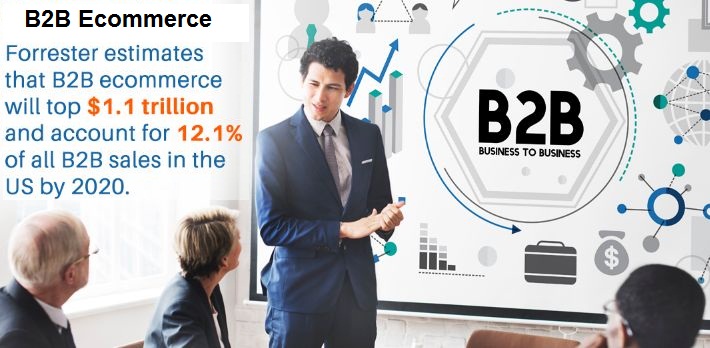In recent years, the landscape of business-to-business (B2B) commerce has undergone a significant transformation, propelled by the rapid advancement of technology and changing consumer behaviors. The traditional model of B2B transactions, characterized by lengthy sales cycles, manual processes, and personal interactions, has evolved into a dynamic and streamlined ecosystem powered by ecommerce platforms. This shift has unlocked immense opportunities for businesses to expand their reach, optimize operations, and drive unprecedented growth.
The rise of B2B ecommerce has been fueled by several key factors, including the increasing digitization of business operations, the proliferation of internet connectivity, and the growing demand for seamless and convenient purchasing experiences. As a result, B2B buyers now expect the same level of speed, efficiency, and convenience in their purchasing journey as they do in their personal lives.
Moreover, the success of B2B ecommerce can be attributed to its ability to address common pain points faced by businesses, such as complex procurement processes, limited visibility into product availability and pricing, and inefficient order management systems. By leveraging ecommerce solutions, B2B companies can streamline operations, improve transparency, and enhance collaboration with suppliers and customers.
In this context, it becomes imperative for businesses to understand the dynamics of B2B ecommerce, embrace digital transformation, and capitalize on emerging opportunities in the market. This paper will explore the rise and success of B2B ecommerce, highlighting key trends, challenges, and best practices shaping the future of this dynamic and rapidly evolving industry.
Turnkey PROS Ecommerce Open Platform
 B2B Ecommerce Statistics (Source Bigcommerce.com) :
B2B Ecommerce Statistics (Source Bigcommerce.com) :
- 41% expect more than 25% rise in B2B online sales in 2018
- 80% accept payments on their ecommerce website
- 72% accept payments over phone
- 77% accept payments over email
- 23% accept payments via fax
- 94% accept transactions through credit card
- 53% accept transactions through terms
- 51% accept transactions through checks
- 50% accepting transactions through POs
- 26% accept transactions through digital wallets like Apple Pay and Amazon Pay
- 48% have been selling online for more than 5 years
- 78% have been selling online for more than 2 years
- 63% say word of mouth referrals are best for new prospects
- 47% say price is important to closing the deal
- 53% say reputation is important to closing the deal
- 71% say UI/UX is highly important in converting customers on site
- 47% say various payment options like PayU, PayPal, Authorize.Net, Amazon Payments etc. are important to converting customers
- 33% say price transparency is a top fear for not selling online more aggressively
 By 2021, business-to-business (B2B) ecommerce transactions would reach $1.2 trillion as estimated by the report from Forrester Research in 2017 which accounts for over 13% of all B2B sales within the United States. Frost & Sullivan claims that B2B ecommerce will hit $6.6 trillion by 2020. Due to the changing B2B buyer demographic and the success of Amazon Business, B2B brands are looking to digital means to boost sales.
About half of B2B buyers are millennial which almost doubles the number from 2012. A process of business sales should change with the change in the “typical” B2B buyer. BigCommerce carried out a survey of over 500 international merchants who were relying on other businesses (B2B) for at least part of their revenue. It was found that ecommerce is a driving force, not nebulous for B2B. Merchants have the option of taking advantage of that growing opportunity or they are at risk being left behind.
Fax orders are still accepted by almost 23% of B2B retailers with an ecommerce channel. However, that figure is much lower compared to the 3 most popular payment arenas: website: 80%, email: 77%, phone: 72%. The rise of mobile apps and marketplaces like Amazon is a clear sign that B2B retailers are rapidly shifting from nascent ecommerce channel experimentation to full omnichannel sales approaches. B2B retailers are not as new to online sales. About 78% of the B2B retailers have been selling online for longer than 5 years or at least 2 years.
Brands that are not selling through a dedicated website are increasingly preparing to do so in the next 24 months. Like B2C retailers, numerous acquisition channels are used by B2B retailers. 63% of respondents find prospects through recommendation even though word of mouth and referrals are also important to the B2B segment. Social media has an important role to highlight the shift in B2B buyer behavior and its move toward a more B2C behavior path. To hit their “ease of online purchase” goals, B2B businesses need some of the following or all of them: credit limits, quoting, price list, purchase orders, quick order forms, purchasing approvals, financing and bulk pricing. 71% of B2B buyers focus mainly on easy site navigation to make sure that their websites are converting all B2B buying prospects that land on site. In the 2018 B2B ecommerce report executive, 41 % of B2B retailers expect B2B online sales to increase more than 25% by the end of the year. To drive net new customer acquisition, decrease manual back off input and work, retain happier customers than ever before, multi-million dollar B2B businesses use ecommerce.
Your CRM system, your planning system, accounting and inventory management system should be glued firmly together by your B2B ecommerce system. Qualities like scalable, easy to alter and flexible B2B ecommerce system make it easier for the company to prosper and expand into new markets where multiple language interfaces are needed.
Choose any B2B ecommerce system as long as that is adaptable to multiple devices. Buyers expect a flawless, professional online process which can involve switching from one device to another but experiencing the same efficient website with item lists and ordering details. Therefore it is advantageous to make sure that your systems are flexible from the very beginning even if you do not control a huge proportion of the market yet.
For businesses to delve into the internet arena and establish their online presence, B2B ecommerce is crucial to reach the customers globally. If it is done correctly, it proves to be a powerful tool that guarantees large returns. You have to improve the customer experience and increase efficiency of the ordering process and for that your systems should all operate and agree with each other.
By 2021, business-to-business (B2B) ecommerce transactions would reach $1.2 trillion as estimated by the report from Forrester Research in 2017 which accounts for over 13% of all B2B sales within the United States. Frost & Sullivan claims that B2B ecommerce will hit $6.6 trillion by 2020. Due to the changing B2B buyer demographic and the success of Amazon Business, B2B brands are looking to digital means to boost sales.
About half of B2B buyers are millennial which almost doubles the number from 2012. A process of business sales should change with the change in the “typical” B2B buyer. BigCommerce carried out a survey of over 500 international merchants who were relying on other businesses (B2B) for at least part of their revenue. It was found that ecommerce is a driving force, not nebulous for B2B. Merchants have the option of taking advantage of that growing opportunity or they are at risk being left behind.
Fax orders are still accepted by almost 23% of B2B retailers with an ecommerce channel. However, that figure is much lower compared to the 3 most popular payment arenas: website: 80%, email: 77%, phone: 72%. The rise of mobile apps and marketplaces like Amazon is a clear sign that B2B retailers are rapidly shifting from nascent ecommerce channel experimentation to full omnichannel sales approaches. B2B retailers are not as new to online sales. About 78% of the B2B retailers have been selling online for longer than 5 years or at least 2 years.
Brands that are not selling through a dedicated website are increasingly preparing to do so in the next 24 months. Like B2C retailers, numerous acquisition channels are used by B2B retailers. 63% of respondents find prospects through recommendation even though word of mouth and referrals are also important to the B2B segment. Social media has an important role to highlight the shift in B2B buyer behavior and its move toward a more B2C behavior path. To hit their “ease of online purchase” goals, B2B businesses need some of the following or all of them: credit limits, quoting, price list, purchase orders, quick order forms, purchasing approvals, financing and bulk pricing. 71% of B2B buyers focus mainly on easy site navigation to make sure that their websites are converting all B2B buying prospects that land on site. In the 2018 B2B ecommerce report executive, 41 % of B2B retailers expect B2B online sales to increase more than 25% by the end of the year. To drive net new customer acquisition, decrease manual back off input and work, retain happier customers than ever before, multi-million dollar B2B businesses use ecommerce.
Your CRM system, your planning system, accounting and inventory management system should be glued firmly together by your B2B ecommerce system. Qualities like scalable, easy to alter and flexible B2B ecommerce system make it easier for the company to prosper and expand into new markets where multiple language interfaces are needed.
Choose any B2B ecommerce system as long as that is adaptable to multiple devices. Buyers expect a flawless, professional online process which can involve switching from one device to another but experiencing the same efficient website with item lists and ordering details. Therefore it is advantageous to make sure that your systems are flexible from the very beginning even if you do not control a huge proportion of the market yet.
For businesses to delve into the internet arena and establish their online presence, B2B ecommerce is crucial to reach the customers globally. If it is done correctly, it proves to be a powerful tool that guarantees large returns. You have to improve the customer experience and increase efficiency of the ordering process and for that your systems should all operate and agree with each other. Zahoor Bhat has over 10+ years of experience as an online editor and media manager. He has worked with major online news and content sites as a media manager. He is well versed with major content management systems and web platforms such as WordPress and social media networks including Facebook, Twitter, Youtube, Google Business, Yelp, Instagram & Linkedin. He is an expert in content creation, proofreading and finally making it live. Being a social media expert, he is able to make relations with social media influencers and make sure to generate leads and grow business via different social media platforms.



